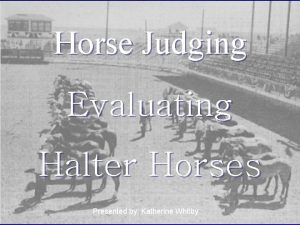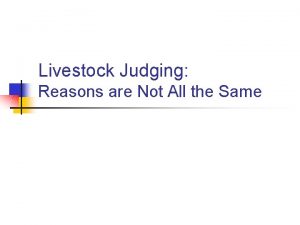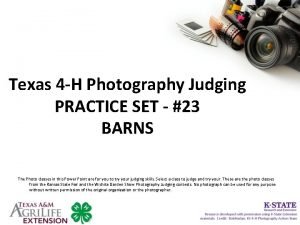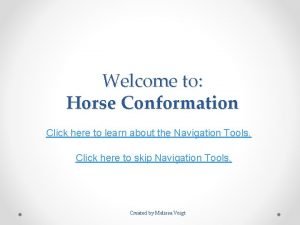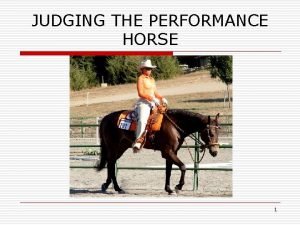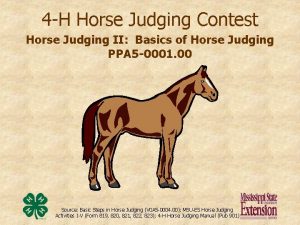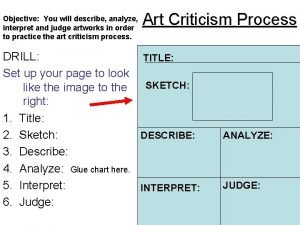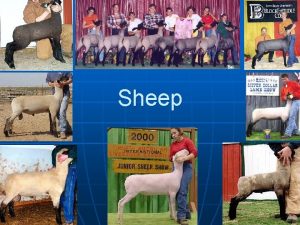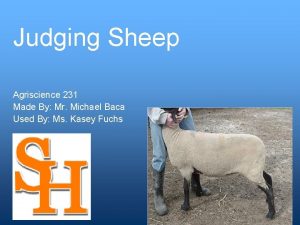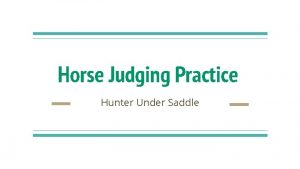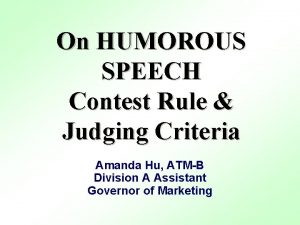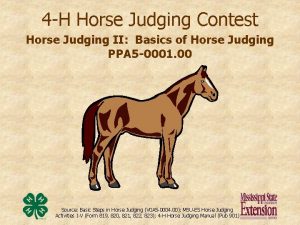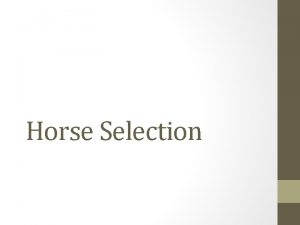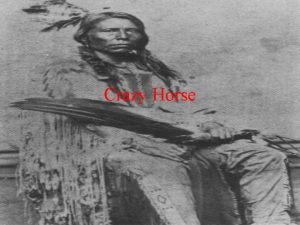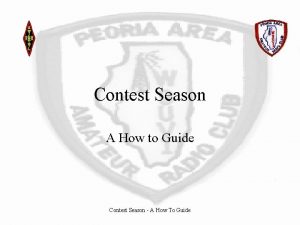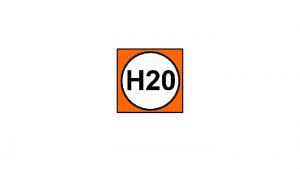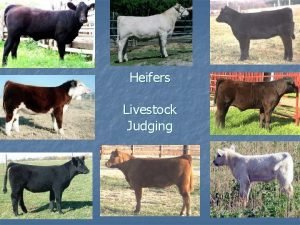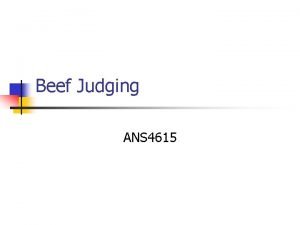COMPETITIVE HORSE JUDGING Contest and Reasons Guide A



























- Slides: 27

COMPETITIVE HORSE JUDGING Contest and Reasons Guide

A successful judge. . • CLEAR mental picture of the ideal type • Deductive reasoning • Logical decision under pressure • Defend your placing of a class • You may have bombed it, but don’t show it!

How a Contests Works • Judge live or video classes • Halter and Performance Classes • Classes will have 4 horses in them • You will be in arena for Halter • You will be in stands for Performance • Place horses 1 -4 based on the criteria for the class • Turn in card after each class • Specific Classes will be chosen to given reasons on • Essentially defending WHY you placed a class a certain way

Scoring • Placing • There will be an official placing that will have “cuts” assigned to it Cuts are how close or how different the horses are • Larger cut—bigger difference in horses • Smaller cut– smaller difference in horses • From there, placings are scored on how close the contestant placing matches the official • 50 is a perfect score • Reasons • How well contestant is able to speak and use terminology to defend the placing of a class • 50 is a perfect score • Notes cannot be used

How to use a Judging Card YES NO

A Good Set of Reasons. . • Absorb and RETAIN a mental image of the good and bad points of the horse • Scored 0 -50 • 75% based upon accuracy • 25% based on oral interpretation • 3 critical points for obtaining a high score • Speak with CONVICTION, truly communicate that your placing’s are CORRECT • Grammatically correct! • Pauses and periods • Two minutes or less!

5 Basic Parts of a Reasons Set 1. 2. 3. 4. 5. Opening Statement Comparisons Grants Criticisms Transitions

Opening Statement • FIRST IMPRESSION • Say something obvious, summarize the class briefly • Use colors of horses to help you • Mistake free and accurate • “Ma’am, I placed this class of Western Pleasure 1 -2 -3 -4, with my top two individuals being the most desirable and consistent movers, I preferred 1 over 2 as…” • “Ma’am I placed this class of Western Pleasure 1 -2 -3 -4. Starting with my initial pair of more broke individuals that also displayed a higher quality of movement, I • “Ma’am I placed this western Pleasure class 1 -2 -3 -4 with consistency and higher quality of movement being my major criteria for the placings in this class. In my initial pair of higher quality movers of 1 the bay and 2 the sorrel, I preferred 1 over 2 as…. ”

Comparisons • Bulk of set of reasons • POSITIVE evaluation • 3 -5 main points • Keep it fundamental

Grants • Give credit to the inferior animal in an area where it surpassed the higher placing animal • Desirable synonyms • NEVER use the same comparisons and grants

Criticism • Faults • Last place animal heavily criticized, but not overly critical • Undesirable traits

Transitions • What makes the reasons flow • Furthermore, in addition to, moving on, looking at my, when evaluating. . • UNIQUE to set you apart

Taking Notes on a Class • ABSOLUTELY NECESSARY • Help you visualize the class • Develop your own short hand • Enough information to remember the class later

Presenting Oral Reasons • ORGANIZATION!!!!!!! • Comparative terms • DO NOT use better, good, best • Louder than normal voice • Confidence and enthusiastic • Facial Expressions add to your voice • Start by giving your placing and then go into pair comparison • Give placing’s at end and say Thank You.

Sample Sets • https: //www. youtube. com/watch? v=M 9 r. Br_Kun 1 Y • https: //www. youtube. com/watch? v=ofufr-C-Xlg • https: //www. youtube. com/watch? v=n. BZTd. LYC 9 u. E • https: //www. youtube. com/watch? v=qp. TQS-cyvsc • https: //www. youtube. com/watch? v=Pyv. Uxas. C 2 t. Y • Mixes up her numbers at the end

Practice Judging











 Halter horse judging
Halter horse judging Drawing competition criteria
Drawing competition criteria Livestock judging reasons
Livestock judging reasons Poultry judging reasons
Poultry judging reasons Livestock judging transition terms
Livestock judging transition terms The contest at mount carmel
The contest at mount carmel Horse judging 101
Horse judging 101 4-h photography judging
4-h photography judging What does this image show
What does this image show Western pleasure horse judging practice
Western pleasure horse judging practice 4 h horse judging manual
4 h horse judging manual Pharmacology introduction
Pharmacology introduction Rivalry chapter 5
Rivalry chapter 5 Which market is the least competitive
Which market is the least competitive The persistence of memory analysis
The persistence of memory analysis Judging and grading of milk
Judging and grading of milk Thank you judges
Thank you judges International speech contest topics
International speech contest topics Judging sheep
Judging sheep Judging sheep
Judging sheep Livestock judging 101
Livestock judging 101 Target indication clock ray method
Target indication clock ray method Holistic and analytic rubrics difference
Holistic and analytic rubrics difference Hunter under saddle judging
Hunter under saddle judging Texas ffa poultry judging
Texas ffa poultry judging Fll robot design presentation
Fll robot design presentation Fll robot design judging
Fll robot design judging Criteria for judging speech
Criteria for judging speech
